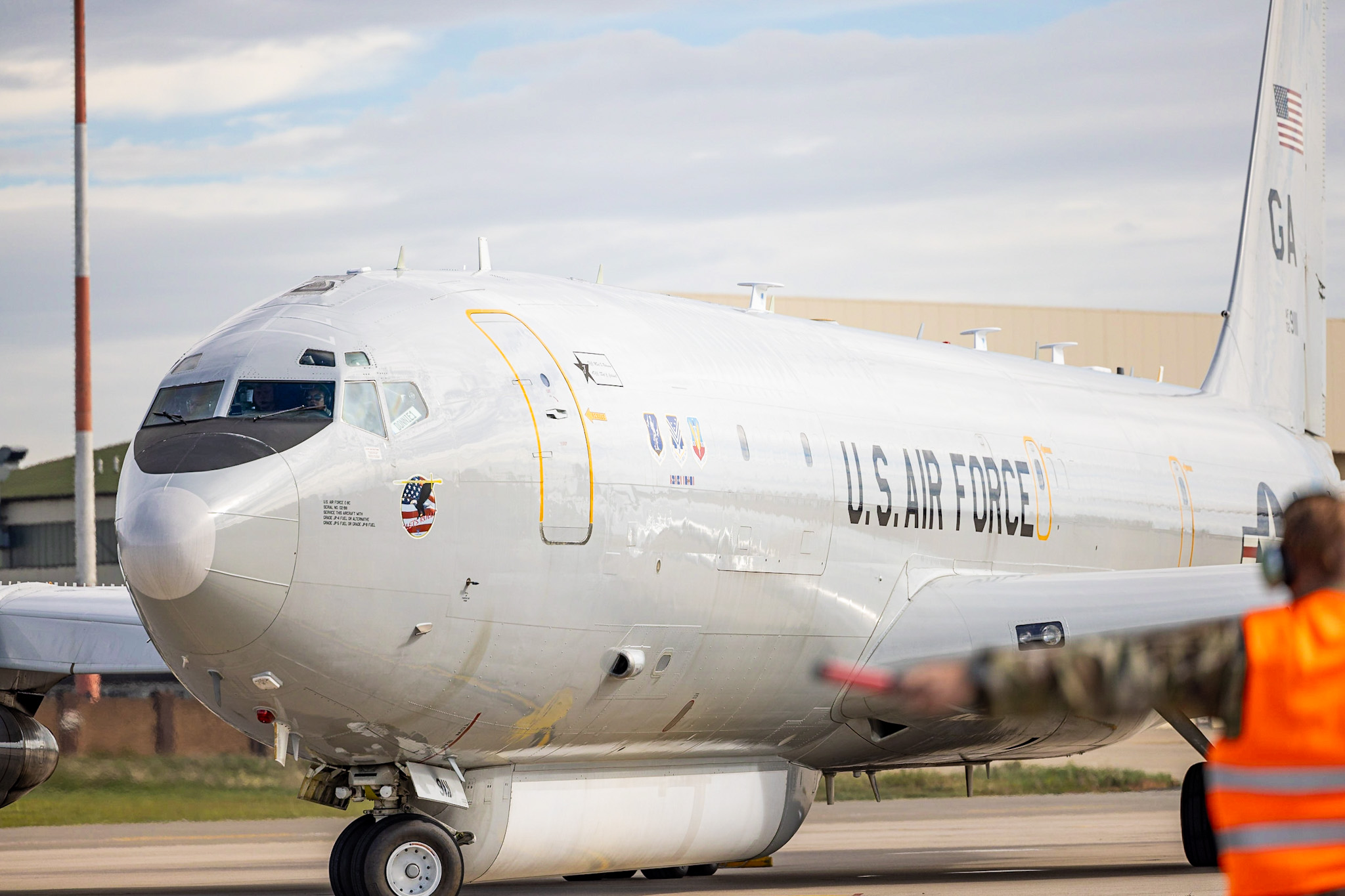This week, the US Air Force (USAF) retired its only E-8C Joint Surveillance Target Attack Radar System (STARS) aircraft. The aircraft had spied on Russian ground movements until the beginning of the war and flew its last mission three months ago, at the height of Ukraine’s counteroffensive.
A specialist mission aircraft, E-8C performs battle management, ground surveillance, and command and control. The aircraft is one of the five North Atlantic Treaty Organization (NATO) planes that flew over the block’s territory just outside Ukraine’s west and south, providing intelligence to Kyiv’s army and helping it plan many of its attacks and avoid Russia’s aerial strikes.
In fact, in December, when tensions in Ukraine were rising, and the US was accusing Russia of preparing to launch a war, the E-8C flew right over eastern Ukraine. It mapped Russian Donetsk and Luhansk separatist militias’ ground placements.
Moscow has long pointed to planes like the RC-135 Rivet electronic warfare, E-3C Airborne Warning Control System (AWACS), and RQ-4B Global Hawk that are airborne nearly 24×7 and collect electronic intelligence on Russian radars and keep an eye on Russian territory.
This helps Ukraine plan its naval kamikaze drone strikes on Crimea and Moscow, receive targeting data, and prepare for Russia’s periodic air-launched cruise missile barrage.
These planes lent Ukraine an undeniable advantage, helped prolong the war, and, from Russia’s perspective, allowed drone strikes on its legitimate territory in Moscow and Belgorod. Calls for Russia to shoot down these aircraft had intensified from its many leading ‘Military Bloggers’ following the Storm Shadow missile strike on the Black Sea Fleet headquarters at Sevastopol.
End Of An Era
According to a Facebook post by the 116th Air Control Wing of the Georgia Air National Guard that took control of the E-8C J-STARS at the Robin’s Air Force Base (AFB) in Georgia, the E-8C was employed for 22 years in service. “It has played a vital role in countless operations supporting troops and safeguarding nations. Thank you for the many members that enabled this mission to be a success over the last two decades,” said the post.

Before the landing at Robin’s AFB, the E-8C flew the last active mission from Ramstein in Germany on June 26, when Ukraine was sending – and losing – hordes of Leopard tanks and Bradley Infantry Fighting Vehicles (IFVs) before Russian defenses in its infamously disastrous counteroffensive. At the time, the E-8C was operated by the 10th Expeditionary Airborne Command and Control Squadron.
“After over 20 years of communicating real-time situational awareness of ground operations to the joint force, NATO partners, and allies, the JSTARS will leave behind a long legacy, spanning as far back as Operation Desert Storm, as the Air Force transitions to more advanced intelligence, surveillance and reconnaissance operations platforms,” said a release from the USAF.
Prying Eye In The Sky
The JSTARS is unique because it is an Intelligence-Surveillance-Reconnaissance (ISR) and command and control aircraft simultaneously, giving ground commanders pictures of the enemy’s movements on land while directing operations from the air.
It has a Synthetic Aperture Radar (SAR), a Ground Moving Target Indicator (GMTI), and a Doppler radar, locating and tracking large numbers of ground vehicles and tanks and displaying broad and detailed battlefield information at standoff ranges.
The E-8C is derived from a heavily modified Boeing 707-300 commercial airliner, with “a lot of these aircraft using technology from the 1950s and 1960,” the USAF press release added.
“The new system replacing the JSTARS is the Tactical Operations Center, currently set up at Robins AFB. This new system provides Airmen more latitude to conduct ISR operations from a ground location,” it further said.
However, in 2018, the JSTARS replacement program was canceled given the manned platform’s vulnerability and their high-end adversaries like China or Russia and their diverse and capable long-range Surface-to-Air Missile (SAM) systems.
Any new jet replacing the JSTARS or replicating its capability would have to operate so far from these advanced Air Defense (AD) systems that it would dilute the efficiency of its advanced on-board sensors.
Two United States Air Force ISR aircraft, an E-8C JSTARS and an RC-135V Rivet Joint, are currently up over the eastern half of 🇺🇦Ukraine:
🇺🇸01-2005 #REDEYE6
🇺🇸63-9792 #HOMER19Also shown: Ukraine Air Force Ilyushin Il-76MD reg. 🇺🇦76697. https://t.co/HZv2krRoFp pic.twitter.com/E8uwXVePq5
— Gerjon | חריון | غريون | ኼርዮን (Deactivated) (@Gerjon_) December 27, 2021
Last Missions
However, the plane continued missions until the last months of its retirement, bearing the importance of air-to-ground reconnaissance and radar imaging. That the aircraft flew from Ramstein AFB means it must have passed over Poland and come closer to western and northern Ukraine.
But its most daring flight mission seems to have been in December 2021, two months before Russia launched its Special Military Operation (SMO). Live flight tracking website Flightradar24 showed a JSTARS and an RC-135 Rivet flying directly over eastern Ukraine, roughly 60 kilometers away from the breakaway statelets of Donetsk People’s Republic (DPR) and the Lugansk People’s Republic (LPR).
“The primary areas of interest for the US intelligence-gathering aircraft would have been on the other side of the border, in Russian territory close to Ukraine. According to official Ukrainian reports, there are around 100,000 Russian troops, while US intelligence considers that figure closer to 70,000 troops.
Either way, these forces are part of a significant Russian military build-up in the region, including heavy armor, artillery, long-range missiles, and air-defense systems,” said a report on The Drive.
- The author can be reached at satamp@gmail.com
- Follow EurAsian Times on Google News